Galactic Cosmic Ray Volleys:
A Coming Global Disaster
Galactic core outbursts are the most energetic phenomenon taking place in the universe. During the early 60’s astronomers began to realize that the massive object that forms the core of a spiral or giant elliptical galaxy periodically becomes active spewing out a fierce barrage of cosmic rays with a total energy output equal to hundreds of thousands of supernova explosions(1, 2).
The cosmic ray electron component of such an outburst is always accompanied by synchroton emission which consists of electromagnetic radiation ranging from radio wave frequencies on up to X ray and gamma ray frequencies. A survey has shown that roughly 15% – 20% of all spiral galaxies are currently seen in their active core explosion phase during which they exhibit Seyfert-like characteristics. One example is Seyfert galaxy NGC 1566 (Figure 1).
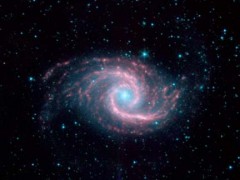
Figure 1. Image of Seyfert Galaxy NGC 1566, a spiral
galaxy whose luminous core is intensely emitting cosmic ray radiation.
(Courtesy of NASA/JPL-Caltech/R. Kennicutt (University of Arizona) and the
SINGS Team)
In some galaxies these active emissions have been observed to equal the energy from billions of supernova explosions. The galaxies undergoing these more intense outbursts are sometimes designated as quasars. Their core emission being so strong as to greatly exceed the stellar emission from the galaxy’s disc, causing the galaxy to have a star-like or quasi-stellar appearance. One example is the spiral galaxy PG 0052+251 (Figure 2) whose active, quasar-like core is radiating 7 times as much energy as comes from all of the galaxy’s stars.
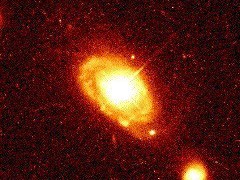
Figure 2. Image showing the luminous quasar-like core of
spiral galaxy PG 0052+25. Taken with the Hubble Space Telescope.
(Courtesy of J. Bahcall and NASA)
(Courtesy of J. Bahcall and NASA)
Conventional astronomy refers to these as “black holes,” visualizing all of the galactic core’s mass to be concentrated at a single dimensionless geometrical point. However, evidence suggests that galactic core mass does not exist in the form of a point singularity, but as a very dense supermassive star having a density similar to a neutron star or hyperon star. In the cosmology of subquantum kinetics, these non-singularity core masses are termed mother stars (see link for more information).

Figure 3. Infrared
image of the Galactic center radio-emitting source Sagittarius A* seen at a
wavelength of 8.7 microns (red spot marked as GC). Taken with the Hale
Telescope. (Courtesy of Stolovy, Hayward, and Herter)
Figure 4. Stars orbiting the Galactic
center 4 million solar mass Mother Star
(Mapped by the UCLA Galactic Center Group)
Paul LaViolette, who is currently president and chief researcher of the Starburst Foundation, was the first to demonstrate that cosmic rays radiated from the active core of an exploding galaxy can penetrate far outside the galaxy’s nucleus to bombard solar systems like our own residing in its peripheral spiral arm disk. He coined the word “galactic superwave” to refer to such a cosmic barrage. Galactic superwaves are a recent discovery. Until recently, astronomers believed galactic cores erupted very infrequently, every 10 to 100 million years.(1) They also believed that interstellar magnetic fields in the Galactic nucleus would trap the emitted particles in spiral orbits causing them to reach the Earth very slowly.(4) For these reasons, most astronomers did not believe that core explosions in the Milky Way posed any immediate threat to the Earth.
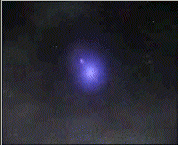
Hypothetical rendition of a Galactic core outburst (from
the video Earth Under Fire, courtesy of Gaiam)
However, in 1983 LaViolette presented evidence to the scientific community indicating that:(5 – 7)
• Galactic core explosions actually occur about every 13,000 – 26,000 years for major outbursts and more frequently for lesser events.
• The emitted cosmic rays escape from the core virtually unimpeded. As they travel radially outward through the Galaxy, they form a spherical shell that advances at very close to the speed of light.
Astronomical discoveries subsequently confirmed aspects of this superwave hypothesis; see Verified Prediction No. 2. For example, in 1985, astronomers discovered that Cygnus X-3, an energetic celestial source of cosmic rays, which is about the same distance from Earth as the Galactic Center (25,000 light years), showers the Earth with particles traveling at close to the speed of light, moving along essentially straight paths.(8) Later, scientists found the Earth is impacted, at sporadic intervals, with cosmic rays emitted from the X-ray pulsar Hercules X-1 (about 12,000 light years distant).(9, 10) The intervening interstellar medium has so little effect on these particles, that their pulsation period of 1.2357 seconds, is constant to within 300 microseconds.
These findings are reason to be gravely concerned about the effects of a Galactic core explosion because they imply that the cosmic rays generated can impact our planet virtually without warning, accompanying the light arriving from the initial core outburst.(5, 11, 12) A study of astronomical and geological data reveals that a superwave from our Galactic core impacted our solar system near the end of the last ice age, 11,000 to 16,000 years ago.(13, 14)
This cosmic ray event spanned a period of several thousand years and climaxed between 15,900 and 12,000 years ago. Although far less intense than the PG 0052+251 quasar outburst, it nevertheless was able to substantially affect the Earth’s climate and energize the Sun. Data obtained from polar ice core samples show evidence of this cosmic ray event as well as other cosmic ray intensity peaks from superwaves impacting the Earth at earlier times (Figure 5).(11, 15)
Figure 5. Graph
showing that cosmic ray intensity has varied considerably during the past
hundred twenty thousand years. Lower profile: Cosmic ray intensity at the
Earth’s surface calculated from variations in the concentration of beryllium-10
in the ice record adjusted for changes in ice accumulation rate. Upper profile:
Global temperature. Climatic zones include: the present interglacial (1), last
ice age (stages 2, 3, & 4), previous semi-glaciated period (stage 5a-d),
last interglacial (stage 5e), and previous glaciation (stage 6).
[An explanation of how this cosmic ray intensity profile was calculated from published beryllium-10 data is presented in the update to Dr. LaViolette’s dissertation and in the appendix of a paper preprint available for download.]
Figure 6 shows the position in the Galaxy of the 15,900 years before 2000 (b2k) superwave when viewed at differing times following the time it passed through the solar system.(5) This elliptical shape of the event horizon is determined by the time it takes the cosmic ray electrons to travel radially outward from the Galactic center at the speed of light plus the time it takes the synchrotron radiation generated by those cosmic ray electrons to reach us at the speed of light. As the superwave expands outward through the galaxy with the passage of millennia, the ellipticity of its event horizon progressively decreases. LaViolette found that the cosmic ray intensity along this ellipsoidal event horizon shell fits the galactic radio background distribution better than any other previous cosmic ray model. He also found that supernova explosion dates coincided with times when the superwave was passing the progenitor star’s location, suggesting that superwaves trigger these explosions.
(5) This elliptical shape of the event horizon is determined by the time it takes the cosmic ray electrons to travel radially outward from the Galactic center at the speed of light plus the time it takes the synchrotron radiation generated by those cosmic ray electrons to reach us at the speed of light. As the superwave expands outward through the galaxy with the passage of millennia, the ellipticity of its event horizon progressively decreases. LaViolette found that the cosmic ray intensity along this ellipsoidal event horizon shell fits the galactic radio background distribution better than any other previous cosmic ray model. He also found that supernova explosion dates coincided with times when the superwave was passing the progenitor star’s location, suggesting that superwaves trigger these explosions.
Figure 6. A galactic
coordinate map (polar coordinates) plotting galactic longitude versus distance
from the solar system in kiloparsecs that views face down onto the galactic
plane (sectioning the galaxy at 0° galactic latitude). The animation shows the
event horizon as its position would appear to an Earth observer for various
times following its initial passage. The event horizon appears as an ellipse
with the Galactic center located at the upper focus and the Earth at the lower
focus. Also shown are the positions of young supernova remnants.
© P. LaViolette 2011
© P. LaViolette 2011
The effects on the Sun and on the Earth’s climate were not due to the superwave cosmic rays themselves, but to the cosmic dust that these cosmic rays transported into the solar system. Observations have shown that the solar system is presently passing through a dense cloud of cosmic dust and frozen debris associated with the North Polar Spur supernova remnant. This material is normally kept at bay by the outward pressure of the solar wind. But, an impacting superwave cosmic ray volley would have overpowered the solar wind and pushed large quantities of this material into the interplanetary environment.
The Sun would have become enveloped in a cocoon of dust that would have caused its spectrum to shift toward the infrared. Radiation back scattered from this cocoon would have caused the Sun’s corona and photosphere to inflate, somewhat like that observed today in dust-choked stars called “T Tauri stars.”. In addition, the dust grains filling the solar system would have back scattered solar radiation onto the Earth, producing an “interplanetary hothouse effect” that would have substantially increased the influx of solar radiation to the Earth. These various solar effects caused atmospheric warming and inversion conditions that facilitated glacial growth which brought on ice age conditions. On occasions when the solar radiation influx to the Earth became particularly high, the ice age climate warmed, initiating episodes of rapid glacial melting and continental flooding.
Details of this scenario are described in the book Earth Under Fire,(12) in Paul LaViolette’s Ph.D. dissertation,(16) as well as in a series of journal articles he has published.(6, 7, 13, 16, 18) LaViolette’s prediction that there is a residual flow of interstellar dust currently entering the solar system from the Galactic center direction was later verified by data collected from the Ulysses spacecraft and by AMOR radar measurements made in New Zealand.(18) For a listing of related theory predictions and their verification click here.
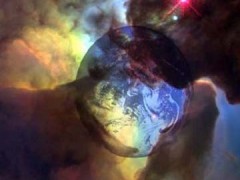
Artist’s conception of cosmic dust and gas present in the
near Earth environment during the time of a superwave passage. In addition, the
circumterrestrial dust cloud, not shown here, would have become particularly
congested with cosmic dust.
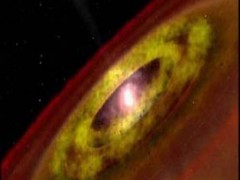
Artist’s conception of the circumstellar dust disc
surrounding a T Tauri star. Similar dust congestion would have been present in
our solar system during the time when the last superwave was passing us at the
end of the last ice age.
Research suggests that the Sun was highly active between 16,000 and 11,000 years ago; see dissertation excerpt Chapter 4. LaViolette hypothesized that this extreme level of flaring activity resulted because the Sun was accreting dust and gas from its dust congested surroundings during this superwave “storm interval”. During this time the sun would have emitted super-sized solar proton events (SPEs), intense volleys of solar cosmic rays, and super coronal mass ejections (CMEs), immense spherical masses of coronal plasma. These would have been large enough to have posed an extreme hazard for life on Earth.
There is evidence that one particularly tragic SPE impacted the Earth around 12,900 years ago, evidence of which is recorded in ocean sediments and polar ice as a spike in both atmospheric C-14 and nitrate ion concentration, the largest to occur during the entire Younger Dryas/Alleröd climatic period.(19) This event happened to coincide with the termination boundary of the two millennium-long Pleistocene mass extinction, beyond which one finds few surviving Pleistocene mammals. This is believed to have been the worst animal extinction episode to occur since the extinction of the dinosaurs 65 million years ago.
It is not much of an inductive leap to conclude that these two events were causally related. As LaViolette has shown, the 12,887 years b2k solar proton event would have been able to deliver a lethal radiation dose to the Earth’s surface. Its effects would have been particularly enhanced if, immediately prior to the event, the Earth’s magnetic field had been weakened by the impact of major coronal mass ejection. Solar cosmic rays in the CME plasma would have become trapped in the geomagnetic field to form storm time radiation belts and the ring current generated by these cosmic rays would have generated a strong magnetic field opposed to the Earth’s field, substantially weakening its intensity.(5, 12) For more about solar-induced geomagnetic excursions, see dissertation excerpt Chapter 3 and Verified Prediction No. 10. A critique of the Firestone-West supernova comet theory is presented in the paper “The cause of the megafaunal extinction: Supernova or Galactic core outburst?”
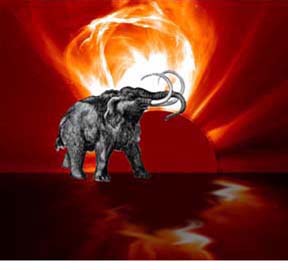 The
extinction of the mammoths and other Pleistocene megafauna could have been
caused by the impact of a supersized solar proton event that may have produced
lethal radiation levels on the Earth’s surface.
The
extinction of the mammoths and other Pleistocene megafauna could have been
caused by the impact of a supersized solar proton event that may have produced
lethal radiation levels on the Earth’s surface.
Abrupt
climatic warming induced by elevated levels of solar radiation reaching the
Earth would have melted the surface of the ice sheets and caused perched
meltwater lakes to form on the ice sheet surface. A dam failure of one of these
lakes would have produced a meltwater avalanche that would have grown in size
as it traveled across the ice sheet and accumulated the contents of perched
lakes along its path. The result would have been a wave of meltwater reaching a
height of 500 meters or more and travelling forward at hundreds of kilometers
per hour. LaViolette coined the term glacier wave to refer to this phenomenon;(5)
see Verified
Prediction No. 12. The occurrence of global warmings during the Alleröd and
at the time of this 12,887 years b2k SPE/CME event would explain why many of
the extinct megafauna are found interred in flood deposits.
Animation showing a glacier wave growing in size and speedas it descends to the edge of the ice sheet.
© P. LaViolette 2011
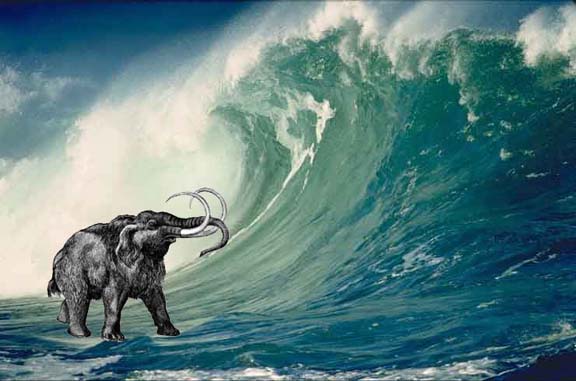
Artist’s conception of a small size
glacier wave
land tsunami overtaking a mammoth unawares.
Galactic Superwaves:
Their
Effects on Life and Society
When cosmic rays from Galactic superwaves impact the Earth’s atmosphere, they produce “electron cascades.” Each primary cosmic ray generates millions of secondary high energy electrons. Many of these particles scatter upwards and become trapped by the Earth’s magnetic field to form radiation belts similar to those created by high altitude nuclear explosions. In just one day, a major Galactic superwave event would inject into the geomagnetic field a particle energy equivalent to 1000 one-megaton hydrogen bomb explosions (1025 ergs). At this rate, the energy delivered to the belts after one year would exceed 30,000 times the energy received from the most powerful solar cosmic ray storms observed in modern times.
Such energized radiation belts could cause a global communications blackout by creating radio static and by permanently damaging critical electronic components of communication satellites. Air travel during such conditions would be extremely hazardous. The resulting atmospheric ionization would destroy the ozone layer, and increase skin cancer rates, due to high levels of UV reaching the Earth’s surface; the cosmic ray particles penetrating to ground level would significantly increase cell mutation rates.
Galactic superwaves may also produce an intense electromagnetic pulse (EMP) whenever a cosmic ray front happens to strike the Earth’s atmosphere. Galactic superwaves such as those that arrived during the last ice age could have generated pulses delivering tens of thousands of volts per meter in times as short as a billionth of a second, comparable to the early-time EMP signal from a high-altitude nuclear explosion (see Figure 7).
In addition, there is the danger that a superwave could transport outlying cosmic dust into the solar system which could seriously affect the Earth’s climate possibly triggering a new ice age. Although there is a small probability that the next superwave will be as catastrophic as the one at the end of the last ice age, even the less intense, more frequent events would be quite hazardous for the global economy.

Figure 7. Intensity
vs. time plot for EMP from a high-altitude nuclear explosion (solid line)
compared to that from a hypothetical superwave (dashed line). The numbers
designate early-time, intermediate-time, and late-time EMP phases (ns =
nanoseconds, µs = microseconds).
In March 2009, the U.S. National Research Council published a report entitled Severe Space Weather Events: Understanding Societal and Economic Impacts; see also March 2009 New Scientist for a summary. It describes hazards to modern society that could occur should we experience a large magnitude solar storm, similar to the 1859 Carrington event solar flare. Many of the adverse effects the report describes are the same as those that would occur during the arrival of a superwave, even one of relatively low magnitude. The four-second extragalactic gamma ray burst that arrived in 1983, did have a measurable effect on radio transmissions used for global navigation and communication.(20) By comparison, the “minor” superwave events discussed above might have total energies hundreds of millions of times greater than this.
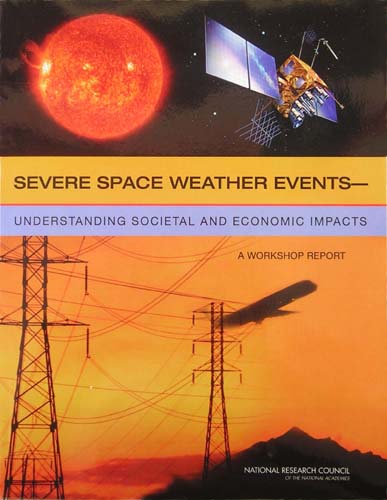
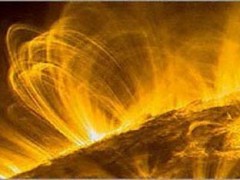
Close up of coronal loops over a solar flare made with
the TRACE spacecraft in 2005 (courtesy of NASA/TRACE)
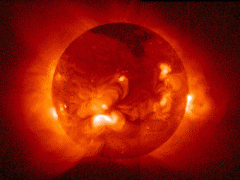
X-ray photo of the Sun showing solar flare hot spots
(courtesy of NASA/TRACE)
(courtesy of NASA/TRACE)
The Frequency and Hazards of Minor Superwave Events
Galactic Center activity occurs frequently between major superwave events. Astronomical observation indicates that during the last 6,000 years, the Galactic center has expelled 14 clouds of ionized gas.(21) See Figure 8 for dates. These outbursts may have produced minor superwave emissions with EMP effects comparable to those of major superwaves. About 80% of these bursts took place within 500 hundred years of one another (Figure 9). With the most recent outburst occurring 700 years ago, there is a high probability of another one occurring in the near future.

Figure 8. History of
minor Galactic Center explosion activity during the past 6000 years;
approximate dates when radiation pulses arrived from the Galactic Center.
(These age estimates taken from Lacy et al. have been decreased by 70% to be
consistent with the value of 7 kiloparsecs for the estimated distance to the
center of the Galaxy.)

Figure 9. Amount of time between successive gas
expulsions from the Galactic center, plotted as a frequency histogram.
At present little research is being done on this important astronomical phenomenon. Nor are we prepared should a Galactic superwave suddenly arrive. International channels of communication are not in place to deal with the disasters that a superwave could bring upon us.
References
1.
Burbridge,
G. R. et al. “Evidence for the occurrence of violent events in the nuclei of
galaxies.” Reviews of Modern
Physics 35 (1963): 947.
2.
Burbidge,
G. R. et al. “Physics of compact nonthermal sources III. Energetic
considerations.” Astrophysical
Journal 193 (1974): 43.
3.
Oort,
J. H. “The Galactic Center.” Annual
Reviews of Astronomy & Astrophysics 15 (1977): 295.
4.
Ginzburg,
V. L., and Syrovatskii, S. I. The
Origin of Cosmic Rays. New York: Pergamon Press, 1964, p. 207.
5.
LaViolette,
P. A. Galactic
Explosions, Cosmic Dust Invasions, and Climatic Change. Ph.D. dissertation,
Portland State University, Portland, Oregon, August 1983.
6.
LaViolette,
P. A. “The terminal Pleistocene cosmic event: Evidence for recent incursion of
nebular material into the Solar System.” Eos
64 (1983): 286. American Geophysical Union paper, Baltimore, Maryland.
7.
LaViolette,
P. A. “Elevated
concentrations of cosmic dust in Wisconsin stage polar ice.” Meteoritics 18 (1983):
336. Meteoritical Society paper, Mainz, Germany.
8.
Marshak,
et al. “Evidence for muon production by particles from Cygnus X-3,” Physical Review Letters 54
(1985): 2079.
9.
Dingus,
B. L. et al. “High-energy pulsed emission from Hercules X-1 with anomalous
air-shower muon production.” Physical
Review Letters 61 (1988): 1906.
10.
Schwarzschild,
B. “Are the ultra-energetic cosmic gammas really photons? Physics Today (ll) (1988):
17.
11.
LaViolette,
P. A. Earth
Under Fire. Rochester, VT: Bear & Co., 1997, 2005.
12.
LaViolette,
P. A. “Cosmic ray volleys from the Galactic Center and their recent
impact on the Earth environment.” Earth,
Moon, and Planets 37 (1987): 241.
13.
Brown,
R. L., and Johnston, K. J. “The gas density and distribution within 2 parsecs
of the Galactic Center,” Astrophysical
Journal 268 (1983): L85.
14.
Lo,
K. Y., and Claussen, M. J. “High-resolution observations of ionized gas in
central 3 paresecs of the Galaxy: possible evidence for infall.” Nature 306 (1983): 647.
15.
Raisbeck,
G. M., et al. “Evidence for two intervals of enhanced 10Be deposition in
Antarctic ice during the Last Glacial Period.” Nature 326 (1987): 273.
16.
LaViolette,
P. A. “Evidence
of high cosmic dust concentrations in Late Pleistocene polar ice.” Meteoritics 20 (1985):
545.
17.
LaViolette,
P. A. “Galactic core explosions and the evolution of life.” Anthropos 12, (1990): 239
255.
18.
LaViolette,
P. A. “Anticipation
of the Ulysses interstellar dust findings.” Eos 74(44) (1993): 510 511.
19.
LaViolette,
P. A. “Evidence for a solar cause of the Pleistocene mass extinction.”
2011, accepted for publication.
20.
Fishman,
G. J. and Inan, U. S. “Observation of an ionospheric disturbance caused by a
gamma-ray burst.” Nature
331 (1988):418.
21.
Lacy,
J. H., Townes, C. H., Geballe, T. R., and Hollenbach, D. J. “Observations of
the motion and distribution of the ionized gas in the central parsec of the
Galaxy. II,” Astrophysical Journal 241 (1980): 132.
Disclaimer:
The synopsis of
the superwave theory presented here should not be regarded as a complete
presentation of this theory for the purpose of scientific debate on the
internet. Those interested in a rigorous presentation of the theory and its
supporting evidence should consult the update of Paul LaViolette’s Ph.D. dissertation (available
in CDROM format) and his various papers some of which are available for download at
this website. His book
Earth Under Fire is also a good resource but is written for a general
audience and is not intended as the primary reference to rely on for scientific
debate.
Disclaimer: The synopsis of the superwave theory presented here should not be regarded as a complete presentation of this theory for the purpose of scientific debate on the internet.
Those
interested in a rigorous presentation of the theory and its supporting evidence
should consult the update of Paul LaViolette’s Ph.D.
dissertation (available in CDROM format) and his various papers some of
which are available for download
at this website. His book Earth Under Fire
is also a good resource but is written for a general audience and is not
intended as the primary reference to rely on for scientific debate.
© The Starburst Foundation
From The Starburst Foundation @ http://starburstfound.org/galactic-cosmic-ray-volleys-a-coming-global-disaster/ ,
From The Starburst Foundation @ http://starburstfound.org/galactic-cosmic-ray-volleys-a-coming-global-disaster/ ,
For more information about galactic superwaves see http://nexusilluminati.blogspot.com/search/label/galactic%20superwave
- Scroll down
through ‘Older Posts’ at the end of each section
Hope you like this
not for profit site -
It takes hours of work every day by
a genuinely incapacitated invalid to maintain, write, edit, research,
illustrate and publish this website from a tiny cabin in a remote forest
Like what we do? Please give anything
you can -
Contribute any amount and receive at
least one New Illuminati eBook!
(You can use a card
securely if you don’t use Paypal)
Please click below -
Spare Bitcoin
change?
Xtra Image by R. Ayana – https://farm8.staticflickr.com/7475/15890887199_3a83f9b7f8_k.jpg
Videos - https://youtu.be/bXaDO-U_2yA
For further enlightening
information enter a word or phrase into the random synchronistic search box @
the top left of http://nexusilluminati.blogspot.com
And see
New Illuminati – http://nexusilluminati.blogspot.com
New Illuminati on Facebook - https://www.facebook.com/the.new.illuminati
New Illuminati Youtube Channel - http://www.youtube.com/user/newilluminati
New Illuminati on Google+ @ https://plus.google.com/115562482213600937809/posts
New Illuminati on Twitter @ www.twitter.com/new_illuminati
New Illuminations –Art(icles) by
R. Ayana @ http://newilluminations.blogspot.com
The Her(m)etic Hermit - http://hermetic.blog.com
DISGRUNTLED SITE ADMINS PLEASE NOTE –
We provide a live link to your original material on your site (and
links via social networking services) - which raises your ranking on search
engines and helps spread your info further! This site is
published under Creative Commons Fair Use Copyright (unless an individual
article or other item is declared otherwise by the copyright holder). Reproduction
for non-profit use is permitted & encouraged, - if you give attribution to the work & author
and include all links in the original (along with this or a similar notice).
Feel free to make non-commercial hard (printed) or software copies or
mirror sites - you never know how long something will stay glued to the web –
but remember attribution!
If you like what you see, please send a donation (no amount is too
small or too large) or leave a comment – and thanks for reading this far…
Live long and prosper! Together we can create the best of all possible
worlds…
From the New Illuminati – http://nexusilluminati.blogspot.com
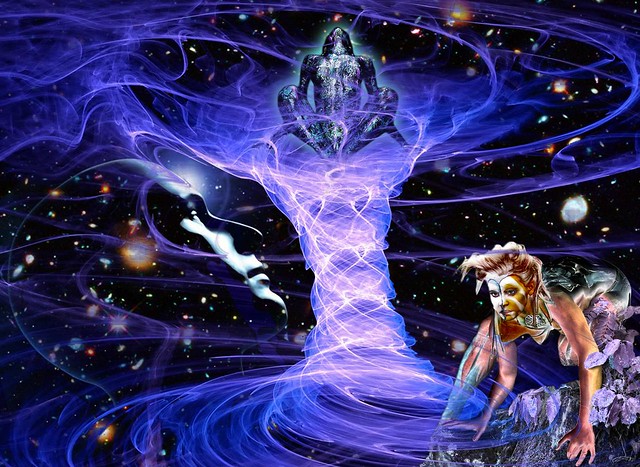

No comments:
Post a Comment
Add your perspective to the conscious collective